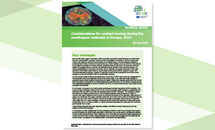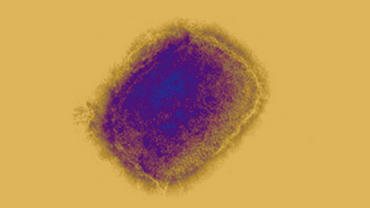Considerations for contact tracing during the monkeypox outbreak in Europe, 2022
In this report, ECDC offers considerations for the prioritisation of efforts to identify and manage close contacts, as well as indicators for public health authorities in the EU/EEA that can be used for monitoring the efficacy of their contact tracing activities.
Executive summary
Since 16 May 2022, cases of monkeypox (MPX) have been reported by several European Union/European Economic Area (EU/EEA) countries. Human-to-human transmission of monkeypox occurs through close contact with infectious material from skin lesions of an infected person, through respiratory droplets in prolonged face-to-face contact and through fomites (e.g. linens, bedding, sex toys, clothing). This outbreak in non-endemic countries is currently primarily spreading among groups of men who have sex with men (MSM) with multiple partners. However, the potential exists for spread in other population groups. The clinical manifestations of monkeypox are usually mild to moderate, as has been observed in most cases reported in the EU/EEA to date. Severity may be higher among young children, pregnant women, and immunocompromised individuals. Isolation of cases and contact tracing comprise the core of the current strategy to control the outbreak of MPX in most EU/EEA countries.
Contact tracing consists of the prompt identification of contacts of a MPX case to allow for management of those exposed and prompt diagnosis of potential secondary cases. It can also help identify settings or population groups where targeted interventions are needed. Collaboration between public health and clinical service providers, particularly sexual health professionals where they exist, who are already experienced and have established procedures for partner notification for STIs, is critical to ensure that as many close contacts as possible are identified.
For this report, we present novel mathematical model-based stochastic simulations of MPX outbreaks. The model has been developed collaboratively by ECDC and the European Health Emergency preparedness and Response Authority (HERA) to provide generalisable insights into MPX outbreaks. The modelling suggests that without any effective contact tracing, most simulated outbreaks continued beyond 12 weeks. In contrast, high rates of effective contact tracing can minimise the chance of new secondary cases beyond 12 weeks. Our results also show larger outbreaks could likely occur if the initial number of undetected cases are higher than one, and in case of a higher value for the number of secondary cases arising on average per case (higher than 2.5). Larger outbreaks, of between 50 and at least 300 cases over an eight-week period, are also likely to occur if there is a delay (>3 days) until cases are isolated and in the case of an incubation period shorter than 10 days.
These findings emphasise that early diagnosis, isolation, and effective contact tracing are key for the effective control of this outbreak.
In this report, we offer considerations for the prioritisation of efforts to identify and manage close contacts, as well as indicators for public health authorities in the EU/EEA that can be used for monitoring the efficacy of their contact tracing activities. Close collaboration with civil society and community-based organisations is important to build trust in contact tracing strategies and to ensure these strategies and accompanying risk communication are adapted to the affected groups, while diminishing stigmatisation.
Download







